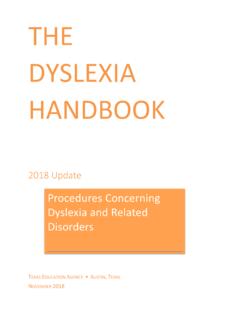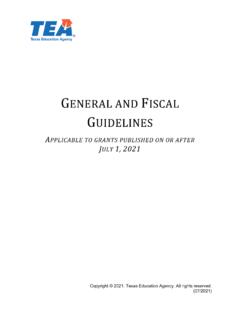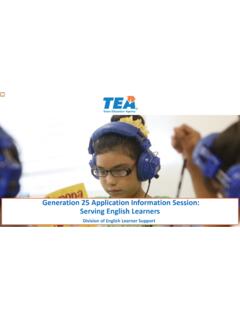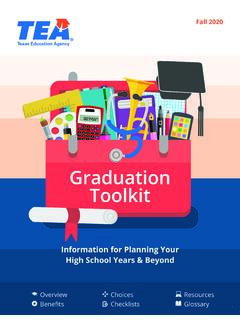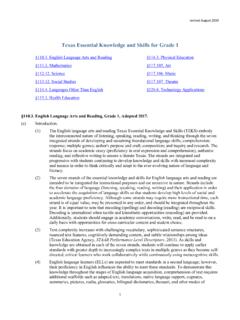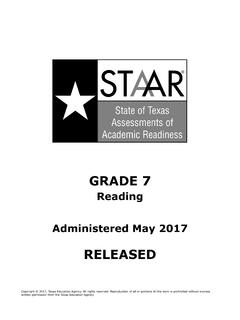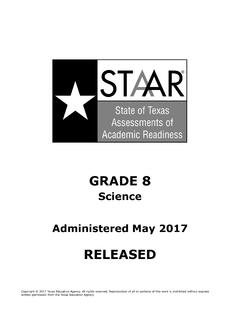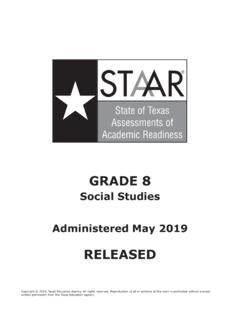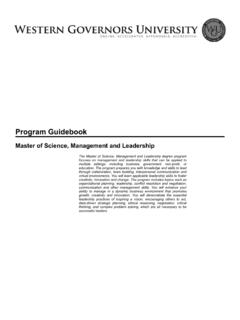Transcription of Attendance and Enrollment - Texas Education Agency
1 SY 20-21 Attendance and Enrollment FAQ June 3, 2021 Attendance and Enrollment FAQ: Section Topics Click on the links below to go directly to that section of the FAQ. Definitions Attendance Methods On-Campus Attendance Requirements o General Attendance Policies o Back-to-School Transition Period o Hybrid Attendance Requirements o Closure o Electives and Extracurriculars Remote Attendance Requirements o General Attendance Policies o Asynchronous Instruction o Synchronous Instruction Class Size Exceptions Calendars and Minutes Requirements Attestations Enrollment Prekindergarten PEIMS Attendance Reporting State Funding Definitions Remote Synchronous Instruction Two-way, real-time/live, virtual instruction between teachers and students when students are not on campus. In this method, the required amount of instructional time is scheduled each day, and funding is generated when Attendance is recorded daily at a locally selected snapshot time.
2 Synchronous instruction is provided through a computer or other electronic device or over the phone. The instructional method must address the required curriculum, per TEC, Remote Asynchronous Instruction Instruction that does not require having the instructor and student engaged at the same time. In this method, students learn from instruction that is not necessarily being delivered in-person or in real time. This type of instruction may include various 2 forms of digital and online learning, such as prerecorded video lessons or game-based learning tasks that students complete on their own, and pre-assigned work and formative assessments made available to students on paper. The instructional method must address the required curriculum, per TEC, Attendance Methods Remote Synchronous Instruction This method replicates the current on-campus method of taking daily Attendance in a remote synchronous instructional setting.
3 In a remote synchronous teaching and learning method, students who are logged in at the teacher s documented official Attendance time are marked remote synchronous present for that day, and students who are not logged in at the teacher s documented official Attendance time are marked absent. An LEA will post on its website and submit to TEA a signed attestation that outlines what the LEA will provide in order to serve students through the remote synchronous instruction method. The attestation must include a summary of training and support for teachers and LEA staff, instructional framework, the platform and technology the district will utilize, grading and progress monitoring, and student access. How Is Remote Synchronous Attendance Measured? Teachers will take and post Attendance as if the student were physically present in the on-campus classroom. In this type of environment, the LEA would need to provide students a minimum number of daily instructional minutes for students to earn full-day funding, as follows: Pre-K through 2nd grade ADA for Foundation School Program (FSP) funding purposes is not available in a remote synchronous method.
4 3rd through 5th grade 180 instructional minutes (not necessarily consecutive) 6th through 12th grade 240 instructional minutes (not necessarily consecutive) Just as with traditional on-campus Attendance , official Attendance will be taken at a certain time determined by the LEA s policy. For remote synchronous instruction, time spent for in-class breakfast and recess has been excluded from the calculation of daily instructional minutes listed above and should not be included in the instructional minutes. If the student is not participating remotely, the student would be marked absent under this option and would generate zero funding for the day. The daily instructional minutes need not be consecutive. A program would meet the remote synchronous method requirements if the daily instructional minute minimums above are met, even if part of the day includes asynchronous activities. For example, a high school program that scheduled synchronous instruction for 120 minutes in the morning, then released students to work independently for several hours before a second scheduled synchronous session totaling 120 minutes in the afternoon would meet the daily instructional minute requirement detailed above.
5 Time students spend participating in work-based learning opportunities can continue to be included in the daily instructional minute calculation. Work-based learning opportunities could include internships, externships, apprenticeships, and mentorships. 3 This method also allows students who are taking career and technical Education (CTE) courses to continue teacher-led instruction and would generate CTE funding. Special Education students who are coded mainstream can receive their regular instruction and special Education services through this remote synchronous instruction method, as well, unless their individualized Education programs (IEPs) reflect that the services must be provided on campus. Local Education agencies (LEAs) are required to maintain daily schedules that document the amount of instruction a student or group of students is scheduled to receive on a given day. The schedule should detail the amount and type of instruction being provided and should also include the official Attendance time the LEA has chosen for the purpose of taking Attendance for funding purposes.
6 Additionally, the LEA is required to attest to what an LEA will provide in order to serve students in remote synchronous instruction. Remote Asynchronous Instruction This method allows LEAs the flexibility to earn daily Attendance through an approved plan for providing high-quality instructional practices with daily engagement measures. LEAs can earn ADA through primarily asynchronous instructional methods OR through a combination of asynchronous and synchronous instruction together. The LEA s approved instructional plan determines the daily engagement, instructional materials, progress monitoring, and teacher supports the students receive in order to earn daily Attendance . For students who typically attend school on campus but may periodically generate daily Attendance via a remote asynchronous instructional method, they should be coded full-day or half-day based on their on-campus schedule. For students who generate daily Attendance via remote asynchronous instructional methods throughout the year: All students in grades kindergarten through 5th grade will be coded for full-day Attendance .
7 Prekindergarten students will be coded as half-day students. Middle school and high school students can be coded as half-day or full-day students, depending on their daily class schedules. How Is Remote Asynchronous Attendance Measured? Measurement frequency is daily. Under an approved learning plan, students earn daily Attendance through daily engagement measure(s). The approved engagement methods are listed below: Daily progress in the Learning Management System (LMS), as defined in the approved learning plan; or Daily progress via teacher-student interactions, as defined in the approved learning plan; or completion /Turn-in of assignments from student to teacher (potentially via email, on-line, or mail). Student engagement with the LMS or other instructional avenues and/or any daily contact by the teacher with a student focused on supporting or monitoring student academic progress, as defined by the approved asynchronous instructional plan, will establish daily Attendance .
8 A student will be considered absent if the student does not have documented engagement with the LMS and/or daily 4 contact with the teacher, and/or documentation of completion /turn in of daily assignments. A teacher or campus representative will input the student s daily Attendance into the Student Information System (SIS) for the asynchronous method, based on the student s daily engagement with the LMS or other instructional avenue and/or the daily contact with the teacher, by marking the student remote asynchronous present or absent on that day. If the LEA has an approved remote asynchronous plan with students participating in both synchronous and asynchronous classes, the student s Attendance recorded by the teacher in the synchronous class can count for official Attendance for funding purposes. A student who misses the synchronous class can still be counted remote asynchronous present for the day by engaging with the teacher or progressing in the LMS during that same day.
9 Remote Course completion (Existing full-time TXVSN) Full-time virtual campuses are currently funded under the remote course completion method. Students must have completed the Texas Virtual School Network (TXVSN) Education program and demonstrated academic proficiency with passing grades equivalent to 70% or above on a 100-point scale. How Is Remote Course completion Attendance Measured? As with the regular, on-campus Attendance calculation, the equivalent of 2 hours of course completion is worth half-day Attendance , and 4 hours count towards full-day Attendance . For single semester courses, completion -based Attendance is calculated for each semester, meaning a student can generate between of an ADA ( completion of 2 hours of courses for one semester) to a full ADA for completing 4 hours in each semester. Students in elementary grades (for example, 4th grade) would either receive full Attendance if the grade-level coursework is completed and the student is promoted to the next grade level or zero Attendance if the course is not successfully completed.
10 On-Campus Instruction When schools are open and operating normally, students are scheduled to attend school each day in accordance with the Attendance requirements of the Student Attendance Accounting Handbook (SAAH) and other laws. Student schedules determine whether they will generate full- or half-day funding, and students generate funding when Attendance is recorded for students who are physically present at school (or otherwise satisfy Attendance requirements under the SAAH without reliance on the COVID-19-based waivers for remote synchronous or asynchronous instruction methods) at a locally selected snapshot time. Instruction that satisfies the requirement of the SAAH will continue to be funded as it was before the COVID-19 pandemic. Meeting the alternative method for on-campus instruction as discussed below will also qualify for on-campus Attendance . Subject to certain exceptions listed below, on-campus instruction must be offered for all grades served by the campus every day for every student whose parents want them to access on-campus instruction for each day a campus is providing instruction given its instructional calendar.
